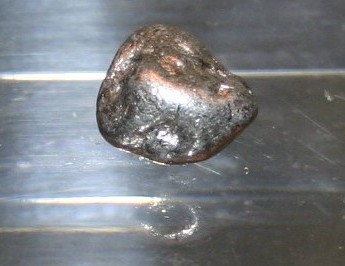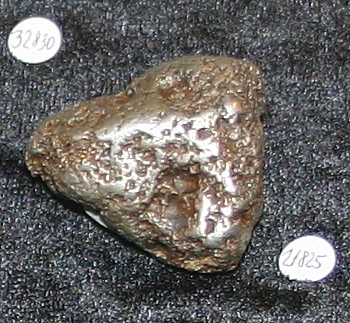Many operators find silver colored heavy materials in their concentrates. Most often this is man made lead, but under certain circumstances it can be placer platinum. Platinum is a white metal of about the same specific gravity with gold, and is found with the latter metal in the placers in various locations, including the basins of the Klamath and Trinity Rivers. Their particles are usually fine scales, only rarely reaching a quarter of an ounce in weight in California, and the largest piece of either ever found was less than an ounce and a half. In Russia and some other locations, the pieces can be larger. The platinum metals cannot be separated from the gold by washing, but they do not unite with mercury, and therefore they can be separated from gold by amalgamation. The source of placer platinum, as an original rock-constituent, is restricted to the most basic igneous rocks, such as peridotites and dunites, or their altered equivalents, the serpentines. With platinum are associated several related platinum group metals, the chief of which are osmium and iridium. These are commonly combined with each other to form the alloys osmiridium and iridosmium. The members of the platinum group occur intimately associated with each other and are found alloyed together in placer deposits. Where one is present, the other members in of the family are usually also present in varying quantities. They are all grayish-white, lustrous, ductile and malleable metals. Native placer platinum typically contains from 16 to 40 percent of the other platinum metals.
Historically speaking, platinum was known to the ancients, for it occurred in many alluvial beds associated with gold, and remained with the yellow metal after the washing of the gold. It was even used by the pre-Columbian Indians of South America. Its existence was noted by Pliny, the ancient roman historian, however it was considered to be some odd form of silver, hence the name (Plata is the Spanish name for silver). In 1735 it was recognized as an independent element by the chemist Uolla in Columbia, South America, and in 1740 it was exported from Jamaica to Europe. Near the middle of the eighteenth century, the Spanish government forbade its further extraction and ordered all the platinum thrown into the seas to prevent its use as an adulterant of gold.
The world’s most productive platinum placers have been the deposits on the eastern slope of the Ural Mountains. In 1819, platinum was discovered in serpentine and other ultra basic rocks on the Siberian side of the Urals. Until 1823, the world's commercial supply of platinum came solely from South America. After that time, Russia became the largest producer until the production of the lode deposits of Africa took over. Platinum, with the metals mentioned above and some gold, has been extracted from the more basic parts of peridotite, dunite, and serpentine masses occurring in the Ural Mountains at Nizhne Tagilsk, Mount Solovief, and other districts, and placers have been worked in the valleys of the rivers Issa, Wyja, Tura, and Njassma, which drain the peridotite and serpentine region. The two principal centers of production were Blagodat on the eastern slope, and Nizhni-Tagilsk, on the western slope. The placers of the Nizhne district are derived from the peridotite masses of Solovsaia. Although the Ural placers taken as a group are the richest in the world, platinum has been discovered in many other regions, such as in the auriferous gravels of the Miask district. In the Ural Mountains, platinum nuggets occur in the gravels of many streams, and all of the productive streams have their headwaters in regions of serpentine, peridotite and pyroxenite bedrock. It is associated with iridosmine, iridium, chromite, and often also with some gold, but the platinum is present in a greater quantity than the gold. The natural platinum forms small rounded grains, and occasionally nuggets of up to 20 pounds in weight, and its fineness ranges from 750 to 850. The remainder being iron, copper, and various metals of the platinum group, particularly iridium.
Second in importance for the historical production of platinum placer material has been Colombia, South America, where placers were worked along the Choco River and its tributaries. In 1735, it was the platinum from these deposits that was first recognized as an independent element, as before that time it was thought to be some odd form of silver. Like the Russian placers, the platinum is obtained in greater proportion than gold. Platinum-bearing gravels occur riverbeds and Tertiary conglomerates. The alluvium of certain rivers in Borneo, which are derived from serpentines and gabbros, also yield platinum. At the Congo Soco mines in Brazil, platinum occurs in the decomposed schistose rocks associated with gold. In New Zealand the placers of the River Tayaka are Also very similar to those of the Urals; they contain osmium and iridium as well as platinum, and are derived directly from peridotites. At the Ruwe gold mine, in the Tanganyika district of Africa, recent alluvial deposits and certain sandstones carry gold, platinum, and palladium, but so far only the placers are worked. The Tulameen district of British Columbia, Canada contains platinum associated with chromite and formerly yielded some production as well. In 1891, the British Columbia furnished platinum placers with a value of $10,000, but that amount dwindled to $3,800 by 1895. It was furnished by the streams of the Similikameen district. It is also found on the Fraser, Tranquille, Yukon. Saskatchewan and Chaudiere, associated with the gold.
In the United States, placer platinum occurs in small quantities together with gold in many of the gold-bearing districts in northern and central California and in southwestern Oregon, where serpentine or peridotite bedrock is found. Platinum also occurs in certain beach sands of northern California and southern Oregon, mixed together with more or less gold. In California, Butte, Humboldt, Siskiou, Trinity, Calaveras, Sacramento, and Del Norte have been the most productive California counties. Most of the production in California came from bucket line dredges. Three-fourths of California production has been obtained from Butte County alone. Platinum is also found in small quantities in a number of the placer gold deposits of Alaska, where significant amounts of platinum have been recovered at some locations. Platinum metals were the primary metal mined by dredging for many years in the Goodnews Bay district. Dredging was only ended in 1975. From 1928 to 1975 roughly 650,000 ounces of platinum were recovered there. Platinum has also been mined in limited quantities in Arizona, Colorado, Georgia and Idaho. Platinum is mained on a commercial scale in Montana where it is extracted from hard rock ores valued chiefly for their palladium.
The ores of platinum include: Native platinum; The only commercially important platinum bearing mineral is sperrylite, PtAs2, which is the most important ore of the metal; platiniridium, an alloy of platinum and iridium; osmiridium, an alloy of osmium and iridium; native osmium and irridium contain small quantities of platinum; it occurs in covellite, which is a sulfide of copper. CuS; and in laurite, which is the sulfide of ruthenium. The mineral, sperrylite, the arsenide of platinum, PtAsa, which occurs in association with nickel-bearing ores of Sudbury, Ontario, and in the Rambler mines, Wyoming. Importance is also attached to the discovery of the metal in trace amounts associated with several copper minerals, as covellite, the sulfide of copper, CuS. With the present high price of platinum, more than twice the value of gold, we may expect a persistent search for platinum ores.
The common parent rock that gives rise to platinum placers is the ultra-basic ferro-magnesian igneous rock known as peridotite. It is normally a dark gray to near black color, but in many locations worldwide, this rock (or a related rock, dunite) has been altered to a waxy, greenish gray rock known as serpentine, because it is so easily converted to this material. This alteration however, does not change the platinum if it is present. Whether it is changed from its original form or not, it is known that platinum occurs as a primary constituent of peridotites and dunites, and specimens showing its intergrowth with olivine and chromite have been described. Nearly all platinum placers have been traced back directly to the decomposition and erosion of such a rock. However, not all occurrences of peridotite or serpentine rocks contain platinum, so not all bodies of such rock lead to the creation of platinum placers. Placer platinum is almost always associated with segregations of chromite, and, although not all chromite segregations will carry platinum, this mineral is an important indicator of the platinum group metals. Platinum is associated with the pre-Cambrian, Cambrian and Ordovician terrains. The origin of the ore bodies is largely through the decomposition of the ferro-magnesian igneous rocks, which allows platinum to be carried into the valleys where it sinks to the lower portion of the gravel and into the cracks and the crevices of the upper portion of the underlying rock. It is, therefore, intimately associated with gold in placer deposits, and may be reclaimed by the same methods as gold.
Early day prospectors looking for gold often considered platinum and the platinum group metals as nearly worthless or merely as a curiosity. Historically, prospectors and miners never made them the chief object of their search, as they had no regular or reliable market for sale, and platinum was worth significantly less than gold. Rich deposits of platinum that did not contain significant gold may well have been ignored by the old timers as not worth working. In more recent times however, platinum is easily saleable, and worth much more than gold. Because of this, the necessity of prospecting all alluvial deposits draining a region of basic igneous rocks that contain chromite segregations cannot be too strongly urged. You could make an important find.
Continue on to:
Platinum Nuggets, Part I: Placers and Deposits
Platinum Nuggets, Part II: The Platinum Group Metals
Return To:
All About Placer Gold
Deposits


